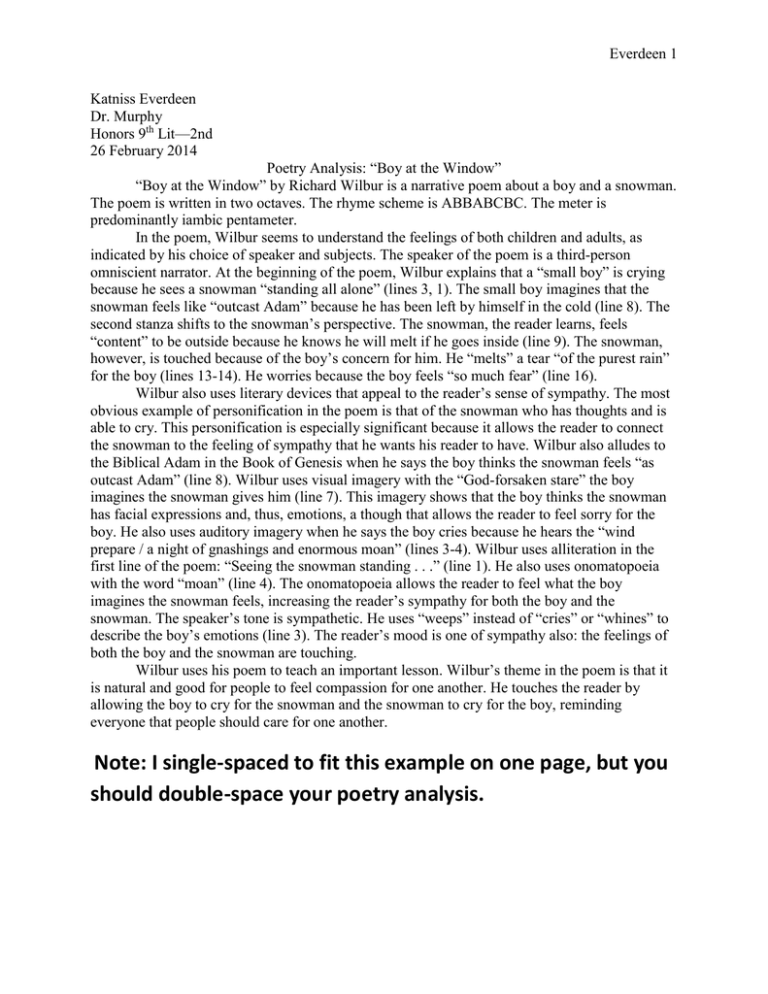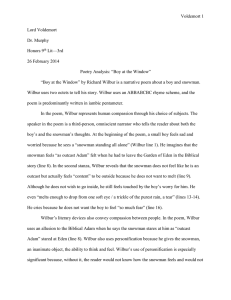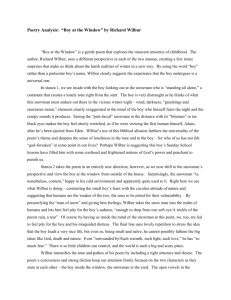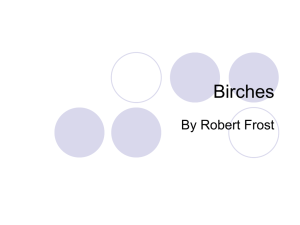Everdeen Katniss Everdeen Dr. Murphy Honors 9th Lit—2nd 26
advertisement

Everdeen 1 Katniss Everdeen Dr. Murphy Honors 9th Lit—2nd 26 February 2014 Poetry Analysis: “Boy at the Window” “Boy at the Window” by Richard Wilbur is a narrative poem about a boy and a snowman. The poem is written in two octaves. The rhyme scheme is ABBABCBC. The meter is predominantly iambic pentameter. In the poem, Wilbur seems to understand the feelings of both children and adults, as indicated by his choice of speaker and subjects. The speaker of the poem is a third-person omniscient narrator. At the beginning of the poem, Wilbur explains that a “small boy” is crying because he sees a snowman “standing all alone” (lines 3, 1). The small boy imagines that the snowman feels like “outcast Adam” because he has been left by himself in the cold (line 8). The second stanza shifts to the snowman’s perspective. The snowman, the reader learns, feels “content” to be outside because he knows he will melt if he goes inside (line 9). The snowman, however, is touched because of the boy’s concern for him. He “melts” a tear “of the purest rain” for the boy (lines 13-14). He worries because the boy feels “so much fear” (line 16). Wilbur also uses literary devices that appeal to the reader’s sense of sympathy. The most obvious example of personification in the poem is that of the snowman who has thoughts and is able to cry. This personification is especially significant because it allows the reader to connect the snowman to the feeling of sympathy that he wants his reader to have. Wilbur also alludes to the Biblical Adam in the Book of Genesis when he says the boy thinks the snowman feels “as outcast Adam” (line 8). Wilbur uses visual imagery with the “God-forsaken stare” the boy imagines the snowman gives him (line 7). This imagery shows that the boy thinks the snowman has facial expressions and, thus, emotions, a though that allows the reader to feel sorry for the boy. He also uses auditory imagery when he says the boy cries because he hears the “wind prepare / a night of gnashings and enormous moan” (lines 3-4). Wilbur uses alliteration in the first line of the poem: “Seeing the snowman standing . . .” (line 1). He also uses onomatopoeia with the word “moan” (line 4). The onomatopoeia allows the reader to feel what the boy imagines the snowman feels, increasing the reader’s sympathy for both the boy and the snowman. The speaker’s tone is sympathetic. He uses “weeps” instead of “cries” or “whines” to describe the boy’s emotions (line 3). The reader’s mood is one of sympathy also: the feelings of both the boy and the snowman are touching. Wilbur uses his poem to teach an important lesson. Wilbur’s theme in the poem is that it is natural and good for people to feel compassion for one another. He touches the reader by allowing the boy to cry for the snowman and the snowman to cry for the boy, reminding everyone that people should care for one another. Note: I single-spaced to fit this example on one page, but you should double-space your poetry analysis.






